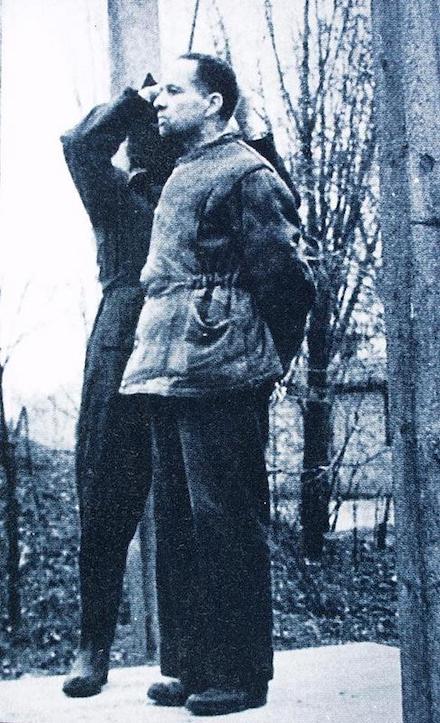The Holocaust stands as one of the most painful chapters in human history, serving as a somber reminder of the atrocities committed during World War II. The profound grief stemming from this dark period has prompted many to creatively express their anguish through various mediums, including literature and film. Among these works is ‘The Zone of Interest,’ a Holocaust film helmed by Jonathan Glazer that delves into the narrative of Rudolf Höss, a Nazi officer who assumes command of Auschwitz.
Starring Sandra Hüller, Christian Friedel, and Freya Kreutzkam, the film follows the story of Höss and his wife Hedwig, who, along with their family, construct a house adjacent to the camp. Their daily routine embodies an inconceivably unsettling lifestyle in stark contrast to the atrocities occurring within the confines of Auschwitz. This juxtaposition of domestic life against the backdrop of such horror paints a horrifying picture of the moral depravity and retrograde faced by those involved in the machinery of the Holocaust. Given the historical setting, one cannot help but wonder if the story is also based on reality.
The Real-Life Rudolf Höss Inspired The Zone of Interest
Yes, ‘The Zone of Interest’ is an adaptation of author Martin Amis’ 2014 book of the same title, developed for the screen by Amis along with the director Jonathan Glazer. The book recounts the factual events surrounding the lives of Rudolf Franz Ferdinand Höss, a German SS Officer, and his wife Hedwig Hensel. Together, they raised five children, two sons and three daughters, and led what seemed like a conventional family life, residing adjacent to the Auschwitz camp, where Höss served as the commander. Rudolf Franz Ferdinand Höss, having served in the First World War, joined the SS in 1934, embodying a committed Nazi officer.

Rapidly advancing through the ranks from Block Leader to SS Captain, he eventually assumed the role of head of the protective custody camp across various regions in Nazi-occupied Europe. Höss’s reputation preceded him, leading to his assignment to assess the establishment of a concentration camp in Poland. His favorable report played a pivotal role in the establishment of the notorious Auschwitz concentration camp in 1940. With meticulous guidance and command, Höss transformed Auschwitz into an efficiently structured concentration camp, expanding it into the massive and infamous complex it became under his leadership.
In 1941, Rudolf Höss received a summons from Heinrich Himmler, who was the Reichsführer-SS and one of the key architects of the Holocaust as well as the chief of the German police. Himmler informed Höss about the Nazi State’s sinister plan known as the ‘Final Solution.’ The term “Final Solution” referred to the systematic genocide orchestrated by the Nazis to annihilate the Jewish population of Europe. This operation aimed at the mass extermination of Jews through various means, including mass shootings, gas chambers, and forced labor.
In response to Himmler’s directive, Höss was tasked with the grim responsibility of devising the most efficient methods to exterminate larger numbers of Jews with relative ease and discretion at the Auschwitz camp. Rudolf Höss initially considered using cotton filters soaked in sulfuric acid for mass killings at the camp. However, he soon stumbled upon a far more lethal and efficient system. Höss began employing hydrogen cyanide, a byproduct of the pesticide Zyklon B, for mass extermination. His innovation and implementation of this deadly method played a pivotal role in Auschwitz becoming the site where the largest number of people were systematically.
Due to some legal issues arising out of sexual misconduct allegations, Höss was made to leave Auschwitz in November 1943, but he was to return. Faced with imminent defeat and recognizing the impending collapse of their regime, the Nazis intensified their genocidal campaigns in a desperate attempt to eliminate evidence of their atrocities and evade accountability. In May 1944, Rudolf Höss was dispatched back to Auschwitz to oversee what would become known as Operation Höss. During this brutal operation, a staggering 430,000 Hungarian Jews were killed in a mere 56 days. Subsequently, in the following months, the pace of atrocities intensified, with approximately 10k Jews being murdered each day.

In November of the same year, Höss was transferred to the Ravensbrück concentration camp, which became his final posting in the waning days of World War II. After the Allied forces emerged victorious and the Nazi regime was dismantled, Nazi officers faced the consequences of their wartime atrocities as war criminals. Fearing arrest, Rudolf Höss assumed the identity of a gardener and sought refuge in Gottrupel, Schleswig-Holstein. However, in 1946, a German Jew named Hanns Alexander, who had fled to Britain and was working as a Nazi hunter, successfully tracked him down. At his trial in a Polish court, Höss provided detailed testimony about his crimes.
Subsequently, on April 2, 1947, he was sentenced to death and hanged on April 16, 1947, with the execution carried out at Auschwitz itself. While awaiting execution, Höss penned a memoir which was published in 1951. The film adeptly navigates the subtleties of the Holocaust, primarily focusing on the tranquility of the Höss family’s domestic life. It subtly introduces the horrors through ambient sounds like screams and gas chambers, choosing to withhold explicit visuals, thereby creating a more haunting backdrop. Remaining faithful to Rudolf Höss’s real story, the film’s honesty in storytelling, coupled with a tactful approach, renders it a poignant and beautiful cinematic piece.
Read More: Best Holocaust Movies


You must be logged in to post a comment.